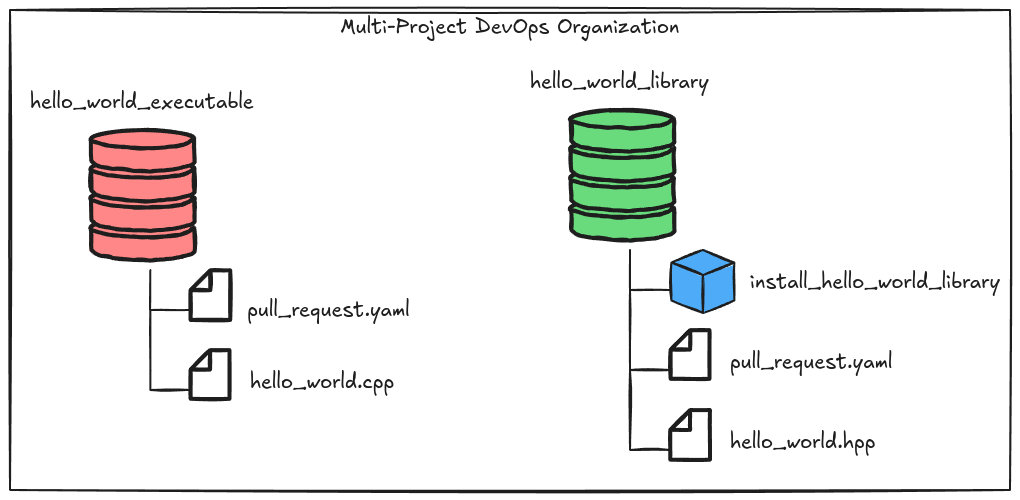Developing Composite Actions
Multi-project CI/CD using GitHub Actions primarily revolves around the development of two types of components: composite actions and reusable workflows. Composite actions are the more fine-grained component and we thus opt to discuss them first.
Developing GitHub Actions requires some familiarity with YAML (a recursive acronym that stands for “YAML Ain’t Markup Language”). Since YAML is a common data serialization language, we assume the reader has familiarity with it; if not, see GitHub Actions Resources for resources which will quickly acquaint you with YAML.
Example Use Case: On-Demand Install
The source code for hello_world_library can be found
here and the
source code for hello_world_executable can be found
here.
One of the most important uses of any programming language is printing the
literal string Hello World to the screen ![]() . To that end, we have
decided to develop a reusable library which downstream users can call to — you
guessed it — print
. To that end, we have
decided to develop a reusable library which downstream users can call to — you
guessed it — print Hello World to the screen. While such a library could be
written most easily in a scripting language like Python, we have opted for C++
on account of the additional complexity which emerges from needing to build the
software before using it (readers should be able to follow this tutorial with
no prior C++ experience).
To this end we create the hello_world_library repository which will house the
source code for the library, a workflow for testing pull requests, and a
composite action for building and installing the library. We also create the
hello_world_executable repository to serve as an example downstream user. The
hello_world_executable repository contains the source for the executable, and
a workflow for testing the executable when a pull request is opened. This is summarized below:

The key CI/CD design consideration here is that building and installing the
library will need to happen in two places. First, the CI/CD for the
hello_world_library repository will need to be able to build and install the
library in order to test pull requests aimed at modifying it. Second, downstream
applications, like hello_world_executable, will need to build the library
during their CI/CD in order to link to it. When the hello_world_library and
one of its consumers are managed by the same organization, this creates the
potential for a large amount of duplicate CI/CD in violation of
DRY. The solution is to rely
on a composite action.
The Solution
The full source of the composite action is available here.
A simplified version of the composite action is shown below.
name: "Install Hello World Library"
inputs:
install_location:
description: "Full path to where the library should be installed"
required: false
default: ${GITHUB_WORKSPACE}/install
do_checkout:
description: "Do we need to checkout Hello World Library?"
required: false
default: true
runs:
using: "composite"
steps:
- name: Checkout Repository
run: |
if $ ; then \
git clone <removed for clarity>
fi
shell: bash
- name: Get Compilers and CMake
run: sudo apt install gcc-11 g++-11 cmake
shell: bash
- name: Configure Hello World Library
run: |
cmake -Bbuild <removed for clarity>
shell: bash
- name: Build Hello World Library
run: cmake --build $/build
shell: bash
- name: Install Hello World Library
run: cmake --build $/build --target install
shell: bash
The action takes two inputs, install_location and do_checkout, which
respectively tell the action where to install the library and whether it needs
to checkout the source code (when used to test pull requests to the ;hello_world_library repository the source code to build will already be
present). The remainder of the action: checks out the repository if required,
obtains the toolchain necessary to build the library, and installs the library
to the desired location. In the hello_world_library repository the composite
action is used like:
name: Pull Request Workflow
on:
pull_request:
branches:
- main
jobs:
test_build:
runs-on: ubuntu-latest
steps:
- name: Checkout Repository
uses: actions/checkout@v4
- name: Install Hello World Library
uses: ./.github/actions/install_hello_world_library
with:
do_checkout: false
whereas in the hello_world_executable repository the composite action’s usage
is:
<removed for clarity>
steps:
<removed for clarity>
- name: Install Hello World Library
uses: MultiprojectDevOps/hello_world_library/.github/actions/install_hello_world_library@v3.0.0
with:
work_directory: $/../hello_world_library
install_location: $
- name: Configure Hello World Executable
run: |
cmake -DCMAKE_PREFIX_PATH=$ \
<removed for clarity>
The key take away from the code examples is that by relying on a composite action we have avoided duplicating the configure, build, install logic for the library.
Now you may be wondering “why a composite action, versus say a reusable
workflow?” The key reason is that if we had used a reusable workflow it would
NOT be possible for steps to occur after the library was installed. This means
that within the hello_world_library repository we could not test the
resulting library and within the hello_world_executable repository we could
not go on to build the application. Another motivation for using a composite
action is to avoid cluttering the downstream logs; put another way, most
downstream consumers are interested in analyzing their workflow’s outputs and
do not want to sift through the logs for installing hello_world_library to
do so.